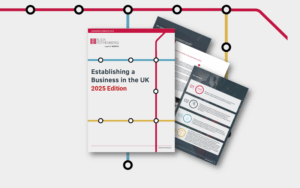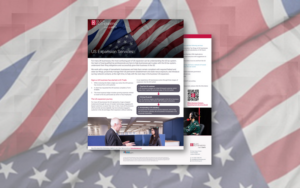Brexit – Customs valuation
What it is and why businesses should care about it?
Simon Sutcliffe (Blick Rothenberg) and Jessica Yang (JY XBorder Consulting Ltd) provide background on customs valuation and recent developments.
Customs duty is levied on imported goods that attract a positive rate of duty. The customs duty rate can be an ad valorem rate (e.g. 12% on t-shirts) or a specific duty calculated using elements other than value of the goods, such as weight (e.g. 948.00 EUR / tonne on pet food).
All imported goods must have a customs value. When the customs duty rate is ad valorem one, the rate is applied to the customs value of the imported goods. As such, customs value has a direct impact on the amount of customs duty payable.
But what exactly is a ‘customs value’ and how is this calculated?
Background on customs valuation and recent developments
Customs valuation is defined as: “a customs procedure applied to determine the customs value of imported goods.”[1] There are six methods of valuation, which must be used in hierarchical order (except methods 4 and 5 which can be reversed).
Primary method:
- Method 1 – Transaction value
Secondary methods:
- Method 2 – The transaction value of identical goods
- Method 3 – The transaction value of similar goods
- Method 4 – The deductive value method
- Method 5 – The computed value method
- Method 6 – The fall-back method
The UK guidance on customs valuation is Notice 252[2] (version April 2020). It currently reflects the previous version of the EU guidance published in 2016. The EU guidance was updated on 17 September 2020[3] which contains some major changes but Notice 252 has not been updated to reflect them.
Customs authorities can assess any customs duty underpaid on historic imports, such as underpayments as a result of an incorrect application of the customs valuation rules over the years. Therefore, it is advisable for businesses to understand customs valuation before becoming an importer.
How is customs value calculated?
In most cases, method 1 is used, which is based on the price actually paid or payable for the goods when sold for export to the UK or the EU, adjusted, where necessary. Method 1 is the most common valuation method and currently covers over 90% of all commercial importations.
For example, where there is a single transaction between a buyer and a seller, the commercial customs invoice price is used as a starting point to calculate the customs value. There are elements that must be included in the transaction value if they are not already included in the invoice price, such as freight and insurance as well as royalties and licence fees. Similarly, there are elements that must be excluded if they are in the invoice price, such as buying commission and delivery costs within the EU.
Determining the customs value is not always straight forward. When unsure, seek assistance before you start to declare a potentially incorrect customs value, which may lead to costly problems in the future.
Examples of situations where customs valuation may require more attention
There are many scenarios where the allocation of a customs value is not simple, such as:
- The business is moving its own goods (e.g. stock transfer), there is no sale and method 1 cannot be used.
- There is more than one sale before the goods are imported, so the last sale must be identified.
- Businesses that are currently relying on the ‘domestic sale’ concept which has now been removed by the updated EU customs valuation guidance.
- Replacement goods, giveaways, samples and free of charge goods
- When using a Buying or Selling agent
- Stock transfer between related parties.
Let’s take a closer look at the last case.
Case study: related party transactions and Brexit
Who are the parties?
European parent companies with a UK subsidiary (and vice versa), or closely related entities in various jurisdictions.
What have they been doing to prepare so far?
They have considered the potential logistical and cost implications of the changing trading relationship between a parent and a subsidiary once the UK becomes a ‘third country’ to the EU post-Brexit transition period. They have concentrated on the movement of stock transforming an intra-EU transfer of goods to a formal import and export regime and the additional documentary and costs burden those changes will bring.
What is still lacking?
Few have delved deeper into how this change will impact Customs Valuation.
Why will customs valuation become relevant?
The related UK/EU company may become the ‘importer of record’, which means they are responsible for declaring the correct value for customs purposes on the customs entry covering the stock movement. This value is usually taken from the commercial invoice accompanying the importation. The relevant customs authority will always seek to ensure that the value upon which customs duty is calculated is a ‘fair and arm’s length transaction’ for customs valuation purposes and that the relationship has not impacted upon the price in a manner consistent with the way the seller prices goods for sale to buyers who are unrelated.
If this transaction is indeed deemed as fair and at arm’s length, then Method 1 of the 6 customs valuation methods can be used. However, preferential pricings, discounts and a host advantageous other pricing policy and ‘rights may affect that ‘transaction value’ between related parties and sometimes rule out the use of Method 1. These pricing policies, in the event of a hard Brexit or a ‘no deal’, may have to be carefully re-thought.
What do they need to look out for when importing into the UK?
After Brexit, the price at which a parent sells to its subsidiary will be far more intensely scrutinised than ever before. Additionally, recent HM Revenue & Customs (HMRC) International trade and compliance visits have begun to focus more and more on the impact on the value for customs purposes of the trading relationship between related parties.
After considering the company’s relationship and any intercompany pricing policies, HMRC may not accept the customs value as declared on the import entry and possibly impose unfavourable and costlier alternative ‘methods of customs valuation’. These could include using values based upon ‘identical or similar goods sold to an unrelated buyer’ (Method 2&3), the ‘selling price’ (Method 4), the ‘production costs of the goods (Method 5)’, to accurately value the goods and possibly forcing up the costs to the UK firm and parent.
Hence, in the event of a ‘hard Brexit’ or ‘no deal’, not only may customs duty and Import VAT costs become applicable but also the value at which those costs are calculated. HMRC or any respective competent tax authority may also make an adjustment to Corporation Tax payable if it is deemed that the transfer price is inaccurate.
As a result, related entities should look closely at their current policies ahead of 1 January 2021 to ensure that they remain compliant to current customs valuation regulations.
What should you do next?
For businesses already importing, check if you are using the most appropriate customs value to ensure you are not over/under paying.
For businesses starting to import, check if you know how to determine the customs value of your imports. If Brexit is the reason you have to start acting as an importer, then there is a small window of opportunity to identify the most appropriate customs value now, before the Brexit transition period ends and you must start to declare a customs value on a customs declaration, which directly affects how much customs duty you will pay.
This article was written by Simon Sutcliffe (Partner, Blick Rothenberg) and Jessica Yang (Director, JY XBorder Consulting Ltd).
To contact Simon use the form below
References:
Contact Simon

You may also be interested in

Is the End of the Triple Lock Pension Inevitable?

The UK is a stable, open and innovation-driven market for Japanese firms to invest in













